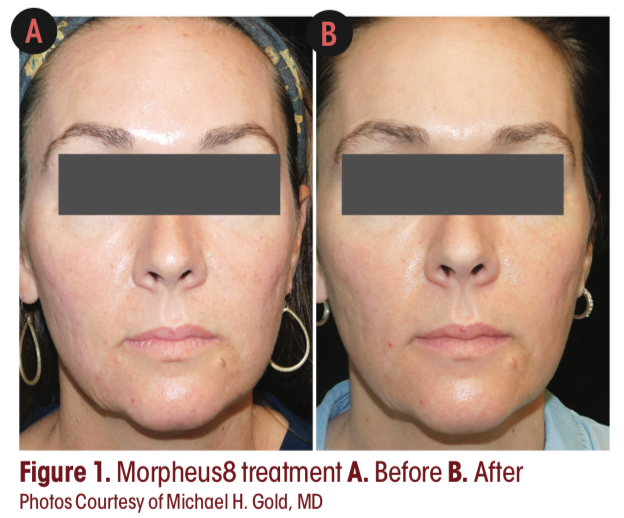- Case-Based Roundtable
- General Dermatology
- Eczema
- Chronic Hand Eczema
- Alopecia
- Aesthetics
- Vitiligo
- COVID-19
- Actinic Keratosis
- Precision Medicine and Biologics
- Rare Disease
- Wound Care
- Rosacea
- Psoriasis
- Psoriatic Arthritis
- Atopic Dermatitis
- Melasma
- NP and PA
- Skin Cancer
- Hidradenitis Suppurativa
- Drug Watch
- Pigmentary Disorders
- Acne
- Pediatric Dermatology
- Practice Management
- Prurigo Nodularis
- Buy-and-Bill
Publication
Article
Dermatology Times
Microneedling Strategies
Author(s):
Microneedling with or without radiofrequency energy has become a very popular cosmetic procedure. Understanding the science behind these versatile devices can help clinicians better harness their therapeutic potential and ensure positive treatment outcomes in their patients.
Microneedling has become an increasingly popular treatment in clinical and aesthetic dermatology because of its minimally invasive nature, positive treatment outcomes, and minimal downtimes, according to Michael H. Gold, MD. Obtaining optimal results, however, requires the right training and device for practice needs.
Gold is the founder and medical director of Gold Skin Care Center, Advanced Aesthetics Medical Spa, The Laser & Rejuvenation Center, and Tennessee Clinical Research Center in Nashville, Tennessee. He provided a profile of microneedling advances and strategies at Maui Derm Live.1
Maximizing outcomes begins with an understanding of the device, its capabilities, and the science behind it, he said. The 4 microneedling techniques currently used, gradually increasing in the depth of skin penetration, include rollers, pens, radiofrequency (RF) pins, and RF needles.
In the procedure, miniature fine needles are superficially and uniformly introduced into the skin in a controlled manner. The resulting controlled skin injury induces rapidly healing micro-punctures and stimulates a wound healing with release of various growth factors, including platelet derived growth factor, transforming growth factor alpha and beta, connective tissue-activating peptide-III, cellular communication network factor 2, and fibroblast growth factor.
The subsequent stimulation of collagen and elastin fiber production leads to skin remodeling and visibly improved clinical outcomes. (Figure. 1)
Figure 1

“Microneedling is a very versatile treatment technique that can be effective in addressing a mosaic of cosmetic and medical concerns,” Gold said, including skin rejuvenation, acne, acne scars, posttraumatic/burn scars, alopecia, drug delivery, hyperhidrosis, and striae distensae.
Rollers are the simplest form of microneedling and can be used at home. Microneedling pens penetrate more deeply and are usually performed by physicians or relegated staff in clinic.
Microneedling pin devices typically only reach the upper dermis, whereas those with needles extend deeper into the dermis creating more dramatic effects. According to Gold, microneedling pins and needle techniques, particularly with the addition of RF, can lead to more robust collagen induction and enhanced clinical outcomes.
“There is a learning curve with microneedling RF pins and needle devices,” he said. “When maximizing their potential, you not only see improvement in collagen to treat scars or rejuvenate the skin, but [you] also get tightening, and lifting.”
Gold says the technique itself has a positive safety profile. Adverse events associated with the procedure, although not zero, are usually minimal and quickly resolve. The procedures also have minimal to no downtime in most cases.
“Training and skill level are paramount in helping to achieve positive outcomes,” said Gold. “Physicians should not expect to just turn these devices on and...get the most amazing results without understanding all the concepts behind them, how they work, and how the skin heals.”
MATCHING PRODUCT TO PRACTICE
Choosing the right microneedling device for the practice can be a daunting task because the market is imbued with an increasing number of competitive devices—all claiming to have the choice technology and best potential therapeutic abilities. When shopping for a cosmetic device, Gold said that it is important to “do your homework” and search for a device from a reputable company.
Some RF microneedling devices come with insulated and noninsulated tips, and some have both available in the system.
“Both needle types have benefits,” said Gold. “I like the noninsulated needle devices for many of the cases I see, but the insulated needle tips have proved to be very useful as well.”
In addition to achieving positive outcomes, practices also need to take into account the downtime required for the devices. When a patient is considering treatment with RF involved, Gold recommended asking them how much downtime they’ll allow—something he does routinely in his practice.
“Similar to the resurfacing days, the more aggressive the treatment, the more dramatic the cosmetic outcomes,” said Gold. “In my treatment plan discussion with patients, I will choose pen, RF pins, or RF needles, depending on how much downtime is available and making sure the patient understands this in advance.”
Gold said patients need to be informed in detail about the procedure and clear on expectations. “It behooves physicians who want to incorporate RF microneedling cosmetic procedures [into] their practice to learn the devices and their science well before proceeding,” Gold said. “This will help ensure positive treatment outcomes and very happy patients.”
Disclosures:
Gold has consulted for, spoken for, or been an investigator for Crown Aesthetics, Collagen Pin, Strata Skin Sciences, Candela, Venus Concept, ENDYMED Medical, Lumenis, and InMode Ltd.
Reference:
1. Gold MH. Microneedling RF & skin tightening—insulated and non-insulated needles—the case for each and new concepts in skin tightening without needles. Presented at: Maui Derm Live In-Person Dermatology CME Conference and Maui Derm Connect Virtual Dermatology CME Conference; January 25-29, 2021; Maui, HI; virtual.






